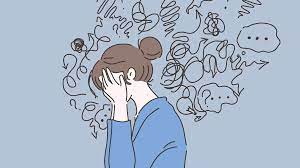Individuals with obsessive-compulsive disorder present excessive, nagging and unpleasant, involuntary but unbearable worries (obsessions), and repeated and irrepressible behaviors (compulsions), aimed at reducing their anxiety, which can take the form of actual rituals .
Typical examples of this disorder are excessive fear of dirt, exaggerated worries of order, fear of harming others and oneself, fear of going crazy, etc.
Pharmacological therapy has recorded considerable progress in recent years, also flanked by behavioral treatments.
Generalized anxiety disorder
- Generalized anxiety disorder is characterized by a state of persistent anxiety and apprehensive expectation that lasts for more than six months.
- Individuals who suffer from it appear tense, irritable, fearful and pessimistic, constantly worried, fatigued.

As with other disorders, physical manifestations of the cardiovascular type (tachycardia, palpitation, tingling), respiratory, gastrointestinal, musculoskeletal (muscle weakness, generalized pain) are often present.
Drug therapy involves the use of benzodiazepines and antidepressants.
Anxiety Disorders
Psychic disorders characterized by the presence of apparently unjustified anxiety and which interfere with the normal course of daily life. Anxiety disorders are divided into generalized anxiety disorder, obsessive-compulsive disorder, phobic disorders, panic attacks.
Phobic disorders
Phobic disorders are characterized by persistent, unrealistic yet intense anxiety linked to external situations or stimuli. Subjects who experience phobic symptoms avoid such situations or stimuli, or try to control them only with great discomfort and this involves a certain degree of maladjustment for those who suffer from it.
Phobic or “phobic” anxiety expresses itself with physiological symptoms such as tachycardia, gastro-intestinal disturbances, suffocation, redness, excessive sweating, tremor and fatigue. An individual may have extreme, irrational and disproportionate fear in the experience of being in open places (agoraphobia), or closed places (claustrophobia), or simply in contact with people, on the phone, in job interviews (social phobia). .
For treatment, drug therapy and cognitive-behavioral psychotherapy are the appropriate and recommended treatment.
Panic attacks
Panic attacks are episodes of sudden and intense anguish of imminent danger. They are accompanied by somatic and cognitive symptoms, such as palpitations, sudden sweating, tremor, choking sensation, chest pain, nausea, fear of dying or going crazy, chills or hot flashes.
These attacks are repeated over time, establishing a state of anticipatory anxiety among them.
Treatment with antidepressant and anxiolytic drugs can be accompanied by psychotherapy.
Summary
Centro ALMA was founded in Taranto in 1996 as a polyclinic center specialized in the diagnosis, treatment and rehabilitation of patients suffering from mood, anxiety and eating disorders.
Subsequently, thanks above all to the experience, studies and research of its Health Director Dr. Nunzio Bucci, the ALMA Center tackles the difficult and complex bipolar disorder with special interest and success.
The ALMA Center employs a team made up of psychiatrists and psychologists with proven expertise and uses the most advanced and modern therapeutic tools. The passion, experience and professionalism of the working group make the ALMA Center a unique center, where difficult questions can find one
